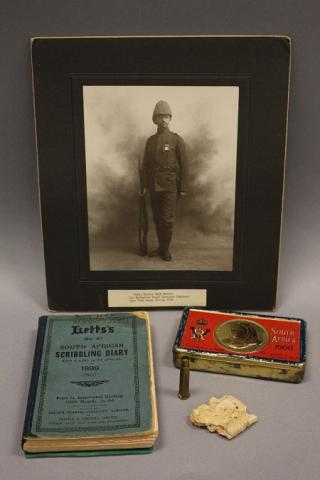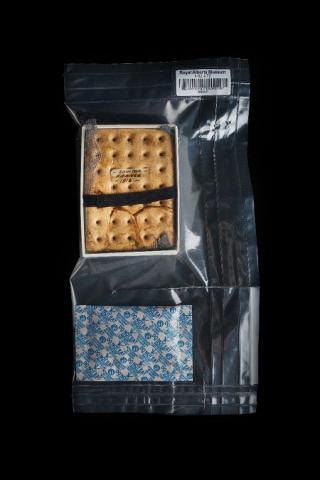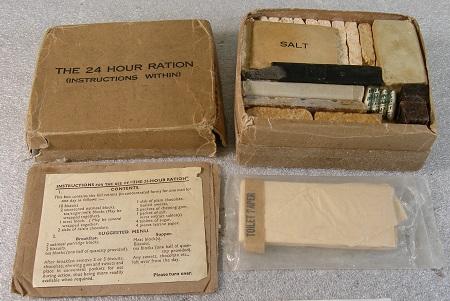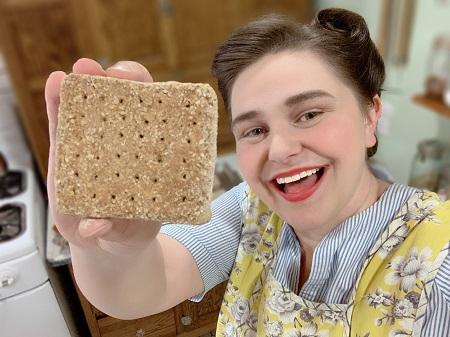Eat like a soldier: Food for Hard Times
by Nancy Nickolson, Family Programs Coordinator, and Matthew Ostapchuk, Acting Curator of Military and Government History
August 5, 2020
Hardtack. It sounds like something you would find at a hardware store, but it’s actually a biscuit that has sustained sailors and soldiers for centuries. Typically made of three simple ingredients – water, flour, and salt – the biscuit is baked, then left to dry and harden. The result: a long-lasting and durable (but rock-hard) biscuit.
Soldiers, with their incredible aptitude for slang, created multiple nicknames for the ration: teeth dullers, molar breakers, sheet iron, dog biscuits, and countless more. Canadian soldiers carried hardtack into battle during the South African War (also known as the Boer War) and the two world wars. When cut off from fresh rations, soldiers relied on these biscuits. Hardtack was often accompanied by other non-perishable foods like canned bully (corned) beef, which soldiers complained was full of fat and gristle.
The biscuits were so hard that soldiers had to soak them in water or tea to make them edible. Some soldiers soaked the hardtack and then fried it in fat. Others crushed it with the butt of their rifle and added it to stew. Soldiers joked that the biscuits were not actually intended to be eaten and made excellent hammers, roof or floor tiles, fuel for fire, and even armour against bullets and shrapnel!
Some soldiers did put hardtack to alternate uses and fashioned it into Christmas cards, letters home, photo frames, pieces of art, and other souvenirs. Soldiers also sent hardtack home to loved ones so that they could get a taste of food from the front.
In the Collection

Walter Hill Moodie, who served with the 2nd Battalion, Royal Canadian Regiment of Infantry during the South African War (1899-1902), brought this piece of hardtack back as a souvenir, along with this shell casing from the first shot he fired at the Battle of Paardeberg, this Queen Victoria Chocolate tin, this diary, and other keepsakes. The South African War marked Canada’s first official deployment of troops overseas.

This piece of hardtack was brought back as a souvenir from the Battle of the Somme during the First World War. The Battle of the Somme (1 July to 18 November 1916) was one of the bloodiest battles in history, with more than one million casualties.

The 24 Hour Ration was designed for landings and assaults, when soldiers were expected to be without fresh rations for extended periods. Included was an inventory of the contents and a suggested “menu,” which featured biscuits at every meal. Edward S. Bryant carried this 24 Hour Ration when he landed on D-Day (6 June 1944) during the Second World War.
How to: Make Hardtack

Taste a piece of history by making some hardtack of your own!
Difficulty: Medium
Time: 1.5 hours
What you'll need:
- 2 cups (325 g) flour, preferably whole wheat
- 1 cup (250 ml) water
- 2 tsp (10 g) salt
Instructions:
- Preheat oven to 375 F.
- Mix flour and salt in a bowl.
- Note: In the video, we used a mix of white and whole wheat flour because our whole wheat flour is very course.
- Add just enough water so the dough sticks together (you might not have to use the whole cup). Knead until it forms a stiff dough.
- Roll out dough to a ½ inch thickness, shaping it into a 6 x 9 inch rectangle. Cut dough into 6 squares, 3 x 3 inches each.
- Make indentations using a nail, chopstick, skewer, or toothpick so it looks like a modern cracker. Don’t poke all the way through the dough.For an added element of authenticity, punch six rows of six holes in the biscuit. This is the pattern featured on the Army No. 4 biscuit, which was produced under government contract by Huntley & Palmers during the First World War.
- Lay out on a cookie sheet and bake in the oven for 30 minutes. Flip and bake for another 30 minutes.
- Store in a dry place (or find out why soldiers of the American Civil War called them “worm castles”!)
- To eat, soak in your favourite beverage or stew. For a historically accurate experience, pair with water or tea.
Enjoy?